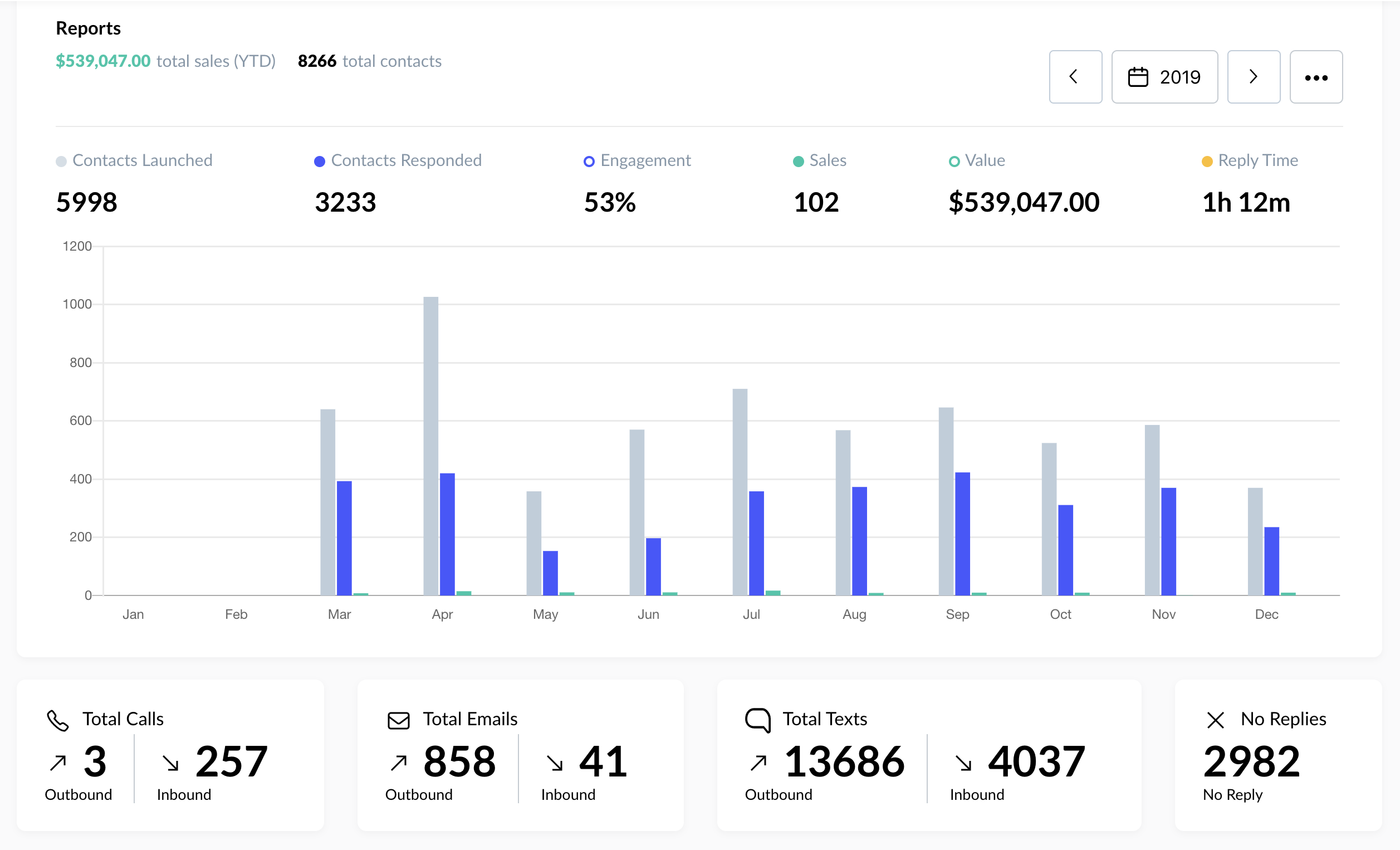How to Use Business Messaging for the Best Customer Experience
Here are steps in the home service business where business messaging can be used to keep the customer informed and engaged, creating the best...
To grow a home improvement business you must follow four key steps. Learn more about those steps and how to accomplish them.
Are you happy with maintaining the status quo?
That’s okay if you are - we've talked to plenty of home improvement execs and owners who are happy with where they are.
But are you different? Are you desperate to want to grow your business?
And I’m not talking about marginal, short-term, quick bursts of growth - I’m talking sustainable growth. The kind of growth that you and your company can rely on, that becomes rinse and repeatable.
According to Statistia, the home improvement industry is set to grow significantly in the U.S. over the next three years, with sales increasing by nearly $50 billion.

How are you positioning your company to take advantage of this bull market?
We've worked directly with hundreds of home improvement companies that have figured out a way to grow year-over-year, and what we’ve found is that the key to sustainable growth isn't about investing more money in marketing.
The key is to focus on four different, but typically overlooked areas of home services businesses -
For folks that want that change and want to attack those challenges, we figured we would share those best practices, proven rinse and repeatable actions you can use in your business.
In this post, we'll discuss the home improvement customer journey and focusing on sales close rates.
When a customer interacts with your business, what does the buying process look like on their end? What are the benchmarks for your business?
As a company, if you don’t have this “journey” well-defined and understood by every member of your team, you’re losing deals.
We sat down with Matt Conley, Owner and CEO at Window World of Richmond to discuss this more in-depth.
Not sure where to start? Let’s start at square one, with some supporting questions to help you get a complete understanding of your company at each step.
We define this step as a how a lead encounters your business and requests a quote for your product.
How long does it take your team to reach out to that lead? Imagine those leads as customers standing around your showroom, waiting for a rep to help them. Don’t be the DMV of home improvement.
How many of those leads are you speaking to within 48 hours? We define 48 hours as the line in the sand for active opportunity and rehash opportunity. Once your customer crosses that threshold, it’s time to mark it as a lost opportunity and engage them differently.
When your lead has done their research and decides to speak with a rep to set an appointment.
Are you interacting with your leads how they want to be communicated with? Studies show that 9 out of 10 people want to have two-way TEXT communication with business.
If you find your team striking out at this stage in terms of setting appointments, try changing up your approach to reaching out to customers.
Lead purchases from your company after appointment
Are you treating the sale as a wedding or a marriage? At this point, many companies let off of the gas, when the opposite should actually be true. Think of this step as a wedding vs. a marriage.
Just getting the sale and scheduling an appointment is a wedding - how are you going to continue adding value and support that customer through the stressful situation of a high consideration purchase? Happy customers means better reviews, and good reviews are the most effective and cheapest type of marketing for any business.
From post-sale to post-installation, this is where you create long-lasting relationships with your customer.
What does your post-sale cadence look like? Don’t leave your customer hanging in the wind - remember, they trusted you enough to buy from you, how are you continuing to add value and build trust?
Though check-ins are okay, you should be thinking at every turn of how to offer value to them with each touch point - is your customer buying new windows? Send an article with information on how to keep their new windows best cared for.
Remember, like any good journey, you should map out any branching journeys off your main course - if a customer requests a quote but doesn’t buy, map out that process and dig into why.
Feeling a bit overwhelmed with mapping out your customer journey? Use this sample template we threw together to help visualize your own.
So, you’ve got your customer journey defined. Now, I want you to take a step back and reframe how you approach your sales numbers.
Too often, we see home improvement companies hone in on the dollar figures each month and, while this is important, they tend to overlook the most important number on the stat sheet - close rate.
Here’s the problem - it’s easy to fall into a line of thinking that your close rate is what it is, and it is most useful as a baseline to forecast sales for your team.
What we challenge home improvement companies to do is focus on that close rate.
Run the numbers yourself! Try out our ROI calculator - if you could increase that close rate by just by a few points, how much would your annual revenue number jump? On average, companies that can increase their close rate by 7 - 10% see an average increase of $300 - $500k per year.
So, the million dollar question - what’s the secret to increasing close rates?
It’s pretty simple actually - authentic conversation and self-review.
How do we define authentic conversation? Think about how you text with your friends, kids and/or significant other versus how you send a client an email. What feels more real? Why not speak with customers like you would a friend or family? That is authenticity, and it is a proven method to form stronger bonds with prospects than any formal email.
This screenshot of one of our clients' reporting tabs is a great example of how consumers LOVE authentic texting - and why that drives results for home improvement companies.

Along with authentic conversations, this is another example of “practice what you preach” here at Hatch. We take time every week to review customer-facing sales calls and measure how our team is performing. This is a best practice that you can apply to your entire team, and a great way to marry your marketing and sales efforts.
Remember - the businesses that talk with customers the most, win the most.
When a customer reaches out to your business, you've got 48 hours to engage them before they become a lost opportunity.
Once your customer passes that threshold, you should define them as a rehash opportunity in your CRM. The question is this - how do you truly enable customer conversations?
4 out of 5 home improvement companies use phone calling as their primary method to get in touch with customers. But in an age of robocalls and fake IRS scams, it just isn't as effective as it was 10 years ago.
I'm not suggesting you eliminate phone calling entirely - I'm saying you need to start complimenting this with other high-touch tools. Specifically business texting.
I may sound like a broken record on SMS, but I truly cannot overstate how important it is that your reps have a way to talk to customers where they want to talk - including texting.
If you haven't implemented texting in your sales process, it's time to start the consideration process - if you wait another year, you're going to be way behind the curve.
We recently chatted with Michael Flores, Chief Operating Officer at Bath and Window Expo about his thoughts on why texting has been so effective at enabling customer conversations for his company.
Customers prefer informal messages when communicating with companies - seems counter-intuitive to everything we've learned in business, doesn't it?
Truth is, communicating with customers should be like texting with your family.
Ten years ago, sales was a numbers game. As long as you sold in bulk, you met your bottom line.
Today, it's getting harder to grow with this mentality.
Getting more leads and business means investing more in marketing, which creates a vicious cycle of spending money to keep your head above water, barely getting a positive ROI.
Over the last few years, what we found is one statistic everyone overlooks that can make a major impact on your bottom-line - close rate.
The problem is that trying to get owners and executives to change their way of thinking from "we need to generate more leads" to "we need to spend more time closing those leads."
More often than not, staying ahead of the curve means forgetting everything you thought you knew about your business.
The entire B2C sales process is seeing a massive shift.
Case in point - the car buying process. Recently, I went through this process and I wanted to share my perspective here to illustrate this point.
It was a great experience for me because I didn't have to put my life on pause to make a high-consideration purchase. Anytime I felt stressed, I just put my phone on silent.
That's the mindset that home business owners and senior-level leaders need in today's sales environment - gathering and responding to leads is important, but your close rate is entirely dependent on how you make the customer feel.
There's really no one-size-fits-all answer to this, but these trends are hard to ignore.
Learn more about what Hatch can do to help you hit your goals.
Here are steps in the home service business where business messaging can be used to keep the customer informed and engaged, creating the best...
Here are some great steps in the home service business where business messaging can be used to keep the customer informed and engaged.
Learn how to get more business from your existing business.
Be the first to know about new sales and marketing insights to grow your messaging strategy with leads and customers.